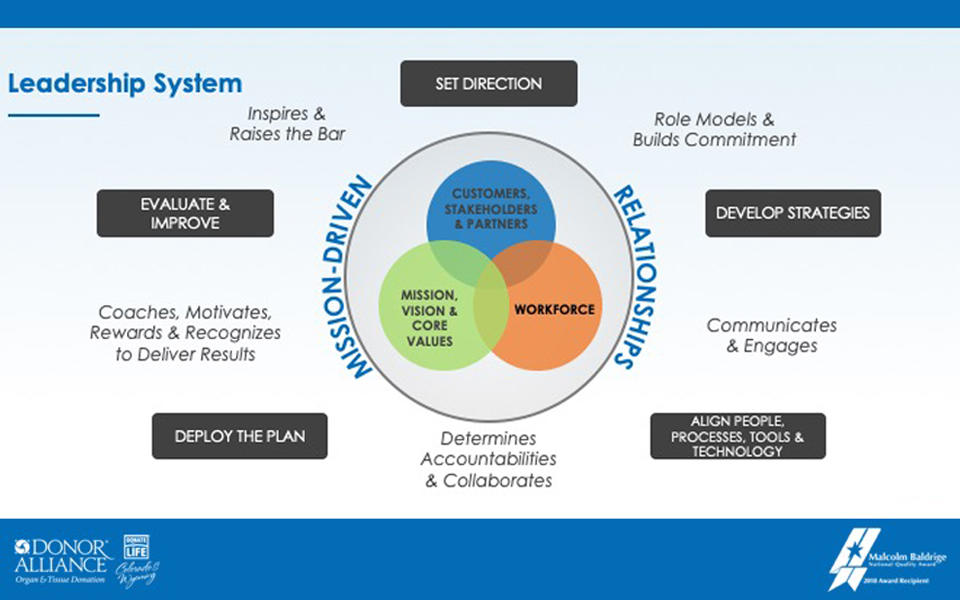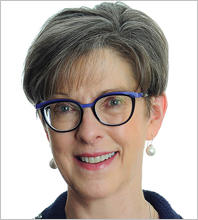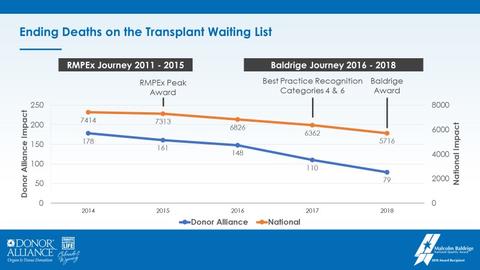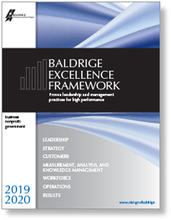Blogrige
The Official Baldrige Blog

Five-Part Leadership Blog Series
In this five-part blog series on the 2018 Baldrige Award recipients’ leadership presentations at the 31st Annual Quest for Excellence® Conference (April 7–10, 2019), senior leaders of the five newest national role models share best practices and stories of how they achieved excellence.
“Days of Miracle and Wonder”

Donor Alliance
2018 Baldrige Award Recipient
“Over the years as transplantation has become a successful treatment option for a wider variety of diseases, the need has dramatically increased,” said Sue Dunn, president and CEO of Donor Alliance. “What has remained constant over time is the generosity of the human spirit. . . . We are fortunate to experience every day the very best of the human condition when people say yes to saving lives.” This “very best” can be seen when people add their names to donor registries, donor families selflessly donate to strangers, and waiting recipients volunteer their time to educate and inspire others, she added.
When it began this work 38 years ago, the organ procurement organization facilitated four transplants. At the close of 2018, Donor Alliance had cumulatively saved 10,710 lives, and more than 1 million lives were healed through tissue transplantation and donation, said Dunn.
Quoting from singer/song writer Paul Simon, she added, “These are the days of miracle and wonder.”
Leadership System
In 2011, Donor Alliance started its improvement journey with its Baldrige-based state program (Rocky Mountain Performance Excellence), and saw its processes and results improve.

Said Dunn, “One of the beauties of the Baldrige framework is how it saved us from ourselves by forcing the really hard questions about organizational systems and what is most essential. . . . Everything flows of course [from] our leadership system.”
The mission—Donor Alliance saves lives through organ and tissue donation and transplantation—is the leadership system foundation. The vision of maximizing all donation opportunities is supported by the values of integrity, leadership, excellence, accountability, and people first.
“These simple, yet power declarations define our purpose,” said Dunn. “They commit us to ongoing future success, and they affirm what’s important to us as an organization.”
Dunn said the core competencies of mission-driven and relationships provide “the atmosphere where mission, vision, values interconnect with the workforce, our key customers, stakeholders, and partners. . . . The science of the system is the full integration of our strategic planning process, where the direction is set by senior leaders and the Board of Directors in collaboration with leadership, and workforce strategies are developed, aligned, and deployed with ongoing evaluation that drives our continual improvement.” She added that its core competencies set the organization apart.
The executive team builds commitment by demonstrating and role modeling integrity, individual character, and accountability, said Dunn. Leadership is developed at all levels to communicate, engage, build accountability, coach, recognize, and reward workforce members—all to reinforce the mission, vision, values, and behaviors that shape the culture, she added.
Dunn added that hallmarks of Donor Alliance include ethical and legal behavior to ensure public trust in the process of organ donation and transplantation. A corporate compliance program ensures that policies outlining behavior are current and relevant, with annual board and staff training, an annual risk assessment, 24/7 hotline for reporting concern, and conflict of interest declarations.
Finding Meaning in Work
People find meaning when there is a connection between what they highly value and the work they do, said Dunn, adding that in Donor Alliance’s 10-year experience of employee engagement surveys, staff members consistently report that the mission is the reason that they come to work and stay.
“It’s with our mission-driven staff who build relationships with donor families, donor hospitals, transplant centers, and tissue processors and importantly with . . . each other that has made us successful,” said Dunn.
She added that being “mission-driven” means that the focus is on the 114,000 patients waiting for a transplant and the 1.5 million patients waiting for tissue grafts.
“For us, being mission-driven means that every day we come to work, we know we have a role in providing the gift of life to those who wait and creating a legacy for the donor,” said Dunn.
Relationships and People First
Donor Alliance’s core competency of relationships is critical given that its defined service area includes as partners 25 donor hospitals in Wyoming and 87 donor hospitals in Colorado. Key customers are four transplant centers and two tissue processors.
According to Dunn, goals and action plans focus on systematic relationships with the partner organizations, warm and consistent relationships with donor families and the community, integrated relationships with transplant centers and tissue processors, and collaborative relationships within the workforce.
“To communicate and engage and to do it authentically is a very powerful leadership quality,” said Dunn, especially in terms of creating an environment for success and integrated governance/public trust.
She said that Donor Alliance has been diligent in creating integrated approaches for frank, two-way communication that includes a variety of listening mechanisms and personal communication to gather inputs, share information, and listen.
As an example, she said that communication with donor families includes walking them through the donation process. After donation, the after-care process is systematic in reaching out to every single donor family at planned intervals. A family counsel serves as a resource, and donor families have a seat on an advisory board.
Dunn said that because donor hospitals are partners, staff are assigned to every hospital, coroner’s office, and drivers’ license office in the states of Colorado and Wyoming. Feedback is solicited during every donor discussion, and third-party surveys are conducted every other year. Partners also have a seat on an advisory board.
In addition, key customers are represented on Donor Alliance’s governing and advisory boards and receive a third-party survey, with results being shared with senior leaders and the workforce. In 2008, senior leaders initiated rounding as a way to increase workforce engagement; 11 years later that practice is still done on a monthly basis.
Also, on a monthly basis, themes that come out through rounding are rolled up through scouting reports for the CEO who reports them at staff meetings. Dunn said she provides a stoplight report with actions and rationales for decisions.
As a core value, “people first” reinforces the core competency of relationships, Dunn said, stating proudly that workforce engagement has improved from 79.9% in 2015 to 90% in 2018, top-decile performance for the nation. In addition, in May 2019, The Denver Post recognized Donor Alliance as a 2019 Top Workplace for the fifth year. It was also recognized as the Best at Making Work Meaningful across all of the newspaper's categories.
Staff are recognized through the long-standing practice of handwritten thank-you notes from senior leaders to employees’ homes.
Satisfied Customers and Other Results
Dunn asked, “What do you get when you combine a focus on performance and action with a strong workforce culture through . . . core competencies and relationships? . . . Our customer experience says that you get satisfied customers.” Dunn reported that customers rated their satisfaction at 100 percent in 2017 and 2018.
Some results for which she is most proud:
- 95% favorability score in trust in senior leaders (top-decile): trust to lead the organization, make strategic decisions, and do the right thing
- 4.9 out of 5 ranking for board engagement (internal metric), board participation, and fiduciary accountability (including to strategic planning, financial oversight, and CEO performance)
“Our population is poised and committed to donation,” she said, with the state of Colorado boasting one of the highest donor designation rates in the country.
“This very public commitment is a testimony to our strong relationship within the community,” Dunn added.
View more processes and results of Donor Alliance.
Five-Part Leadership Blog Series: Upcoming Blogs
Tri County Tech (Education)
Five-Part Leadership Blog Series: Previous Blogs
Integrated Project Management Company, Inc. (Small Business)
Memorial Hospital and Health Care Center (Health Care)
Alamo Colleges District (Education)

Baldrige Excellence Framework
The Baldrige Excellence Framework has empowered organizations to accomplish their missions, improve results, and become more competitive. It includes the Criteria for Performance Excellence, core values and concepts, and guidelines for evaluating your processes and results.
Purchase your copy today!
Available versions: Business/Nonprofit, Education, and Health Care





